 |
| Reviews and Templates for Expression We |
Sustainability reporting & GHG reductions: the verification gap

This is the first in series of three articles discussing the findings and implications of a survey of corporate sustainability, climate change, and environmental management professionals in North America that was conducted by Nima Hunter Inc., with support from the sustainability and environmental services consulting firms Cameron-Cole, LLC. and WSource Group, LLC. This article discusses the implications of a significant gap identified between greenhouse gas (GHG) emissions reporting and GHG emissions verification. The goal of the survey was to assess the current state of sustainability, energy efficiency and GHG reporting and to identify trends associated with GHG management and GHG inventory verification in North America.
Perceptions of risk in a warming world have increased calls for reporting of corporate sustainability performance, climate risk and greenhouse gas management performance. As a result, insurers, investors, regulators and supply-chain managers are not only increasingly “doing the math” attributable to climate change, they also are looking for more assurance that GHG emissions levels, emission-reduction targets and other sustainability data are accurate and reliable. Accurate GHG emissions data plays a crucial role in identifying opportunities for energy reduction and energy-efficiency cost savings, planning for exposure to climate-related operational supply-chain and brand image risks, as well as long-term costs such as potential taxes on emissions.
Nima Hunter Inc.’s survey of sustainability and environmental professionals in North America (download here) was completed in February by 130 respondents from more than 20 industry sectors, with half representing companies operating in carbon-intensive sectors, including oil and gas extraction, utilities, manufacturing, mining and quarrying.
In keeping with the growing demand for sustainability and GHG reporting, the survey found that 80 percent of the organizations reported GHG emissions. Also in keeping with growing interest in energy reduction and energy-efficiency cost savings, the survey found that 89 percent of respondents have implemented energy-efficiency projects and 76 percent percent of the responding organizations reported that they have established GHG emission reduction goals. However, only 51 percent of the GHG emissions inventory reports were verified, meaning that up to 25 percent of the responding companies are basing reduction targets on unverified GHG emissions totals. (See figure below.)

Illustration by Lightspring via Shutterstock
When you disclose your emissions, you want to get it right. Ultimately, reporting issues potentially can result is a significant under- or overstatement of an entity’s GHG emissions. While some facilities and entities have a regulatory requirement to verify their GHG emissions, organizations that voluntarily disclose their emissions do not.
According to Chris Lawless, Director of GHG Management Services at Cameron-Cole, “We find misstatements or non-conformances in 99 percent of the GHG Inventories that we verify. Verification makes sense for all organizations voluntarily reporting and publicly disclosing their GHG emissions. Verification enhances the credibility of reported GHG emissions and also can add approximately 10 percent to your disclosure and reporting scores for companies reporting to the Carbon Disclosure Project.”
According to Prashant Kripalani, Senior Manager of Environmental Sustainability at Clorox, “Verification of our greenhouse gas emissions has validated that we are using accepted calculation methodologies and protocols. It has also increased our credibility with third-party reporting firms like the CDP, which prefers that companies report verified emissions data.”
What does the verification process entail?
According to CDP, the verification process reviews both the climate data provided and the systems, models and controls in place for collecting and managing it. As such, independent verifiers are able to bring objectivity and experience to the data review, enabling inefficiencies and errors to be identified. Ultimately, this assists in the continual improvement of the processes used and the accuracy and usefulness of the data to feed into internal development and cost saving programs.
Starting at the highest level, an independent verification body will affirm that the reporting entity has accounted for all business units, subsidiaries, joint ventures and partnerships in accordance with the selected approach for defining the organization’s boundaries. Once the operational boundaries have been assessed, the verification body then will determine whether all emissions sources and GHGs have been appropriately reported. Emissions are then recalculated to make sure they meet the agreed upon or required level of accuracy, and the emissions report is also evaluated for conformance with GHG reporting program or regulatory requirements.
To ensure that the third-party verification activities undertaken by companies are broadly comparable, organizations such as CDP require that verification to be completed in accordance with recognized verification standards.
So, why aren’t all companies verifying their emissions?
Despite the growing call for verification by investor groups such as CDP, and leadership on the part of brands such as Clorox that have their GHG inventories verified, a significant disconnect remains between companies who publicly report their GHG inventories and those who have their GHG inventories verified.
One reason for the gap may be that verification is perceived as an unnecessary cost or a burdensome process. However, there is strong evidence that failure to verify inventories can leave a company exposed to significant risks and lost opportunities.
According to Lawless, “Our verification clients see significant value in getting their GHG emissions inventory verified. Without an accurate GHG emissions inventory, it is very difficult to establish accurate emission-reduction targets and track progress toward those goals. Beyond confirming the accuracy and completeness of the reported data, the verification process identifies strengths, weaknesses and opportunities for improvement in the reporting entity’s GHG management system and increases the likelihood that opportunities for energy reduction and energy efficiency cost savings are being correctly identified and maximized.”
As GHG emissions become material to a growing number of industry sectors, the reporting of climate data will become an increasingly critical factor in the decisions of investors, insurers, supply chain managers and brand owners. Correspondingly, the growing demand for reliable GHG emission data will be a driver for closing the GHG reporting-verification gap.
|
|
|
|
Copyright 2011 Energy and Technical Services Ltd. All Rights Reserved. Energyts.com |